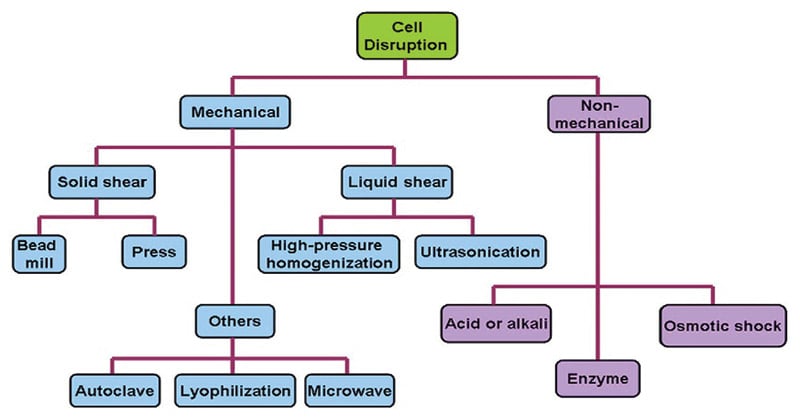- Cell disruption is the process of obtaining intracellular fluid via methods that open the cell wall.
- The overall goal in cell disruption is to obtain the intracellular fluid without disrupting any of its components.
- The method used may vary depending on the type of cell and its cell wall composition.
- Irrespective of the method used, the main aim is that the disruption must be effective and the method should not be too harsh so that the product recovered remains in its active form.
- Cell disruption methods can be categorised into mechanical methods and non-mechanical methods.
- Mechanical methods are divided into solid shear methods and liquid shear methods.
- Non-mechanical methods can be divided into physical methods, chemical methods and enzymatic methods.

Interesting Science Videos
Mechanical Methods of Cell Disruption
Mechanical methods are those methods that required some sort of force to separate out intracellular protein without adding chemical or enzyme
- Mortar & pastel/grinding
- Blender
- Bead beating
- Ultra sonication
- Homogenization
Mortar & Pestle
- It involves the grinding of the cells such that they are disrupted.
- This does not have to be in suspension and is often done with plant samples frozen in liquid nitrogen.
- When the material has been disrupted, metabolites can be extracted by adding solvents.
Blenders
- The use of blenders which employ high speed can be used to disrupt cell walls.
- It is the same process used by centrifugation, which separates or concentrates materials suspended in a liquid medium.
Bead beating
- Glass or ceramic beads are used to crack open cells
- The kind of mechanical shear is gentle enough to keep organelles intact.
- It can be used with all kinds of cells, just add beads to an equal amount of cell suspension and vortex.
Ultrasonication
- Ultrasonic homogenizers work by inducing vibration in a titanium probe that is immersed in the cell solution.
- A process called cavitation occurs, in which tiny bubbles are formed and explode, producing a local shockwave and disrupting cell walls by pressure change.
- This method is very popular for disruption of plant and fungal cells.
Homogenization
- Liquid-based homogenization is the most widely used cell disruption technique for small volumes and cultured cells.
- Cells are lysed by forcing the cell or tissue suspension through a narrow space
- Homogenizers use shearing forces on the cell similar to the bead method.
- Homogenization can be performed by squeezing cells through a tube that is slightly smaller than beads beating.
Non-Mechanical Methods of Cell Disruption
Nonmechanical methods are further divided into three classes which are following :
A. Physical methods
1. Freeze-Thaw
- It is suitable when working with soft plant material and algae.
- Disruption is achieved via a series of freezing and thawing cycles.
- Freezing forms ice crystals, which expand upon thawing, and this ultimately causes the cell wall to rupture.
2. Microwave/ Thermolysis
- Microwave (along with autoclave and other high temperature methods) are used to disrupt the bonds within cell walls, and also to denature proteins.
- However, uncontrolled amount of heat can easily denature or damage target proteins and subtances.
3. Osmotic Shock
- Through the process of osmosis, water can be moved into the cell causing its volume to increase to the point that it bursts.
- The method however, can only work with animal cells and protozoa, since they do not have cell walls.
4. Electric Discharges
- It is also possible to achieve cell disruption via electrical discharges in mammalian and other cells that are bounded by plasma membranes only.
B. Chemical methods
- They are often used with plant cells (and sometimes in combination with shearing).
- Organic solvents such as toluene, ether, benzene, methanol, surfactants, and phenyl ethyl alcohol DMSO can be used to permeate cell walls.
- EDTA can be used specifically to disrupt the cell walls of gram negative bacteria, whose cell walls contain lipopolysaccharides that are stabilized by cations like Mg2+ and Ca2+.
- EDTA will chelate the cations leaving holes in the cell walls.
C. Enzymatic methods
- Another strategy to achieve cell lysis is to use digestive enzymes which will decompose the microbial cell wall.
- Different cell types and strains have different kind of cell walls and membranes, and thus the used enzyme depends on microbe. For example, lysozyme is commonly used enzyme to digest cell wall of gram positive bacteria. Lysozyme hydrolyzes β-1-4-glucosidic bonds in the peptidoglycan.
- The cell wall of yeast and fungi differs significantly from the cell wall bacteria. One commonly used enzyme mixture for degradation of cell wall of yeast and fungi is Zymolyase.
- It has for example β-1,3 glucanase and β-1,3-glucan laminaripentao-hydrolase activities (Zymolyase | Yeast lytic enzyme).
- In addition, the enzymes that are commonly used for degradation of cell wall of yeast and fungi include different cellulases, pectinases, xylanases and chitinases.
- Enzymes such as beta(1-6) and beta(1-3) glycanases, proteases and mannase can also be used to disrupt the cell wall.
Significance of Cell Disruption
- Cell disruption is an essential part of biotechnology and the downstream processes related to the manufacturing of biological products.
- It is necessary for the extraction and retrieval of the desired products, as cell disruption significantly enhances the recovery of biological products.
References
- Wilson, K., Walker, J. (2018). Principles and Techniques of Biochemistry and Molecular Biology (8 eds.). Cambridge University Press: New York.
- file:///C:/Users/user/Downloads/Cell%20disruption%20methods.pdf
- https://www.slideshare.net/sabanaeem1/cell-disruption
- Chisti Y., Moo-Young M. (1986); Disruption of microbial cells for intracellular products; Enzyme Microb. Technol., vol. 8, April; doi: 0141 –0229/86/040194–11.

Very well reseached articles and informative